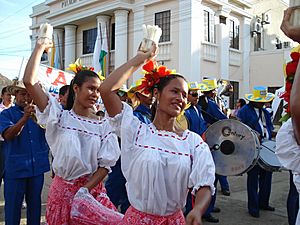Cumbia music facts for kids
Quick facts for kids Cumbia |
|
|---|---|
| Stylistic origins | African music, possibly Guinean cumbe |
| Cultural origins | African and Amerindian slaves in Colombia. |
| Typical instruments | Percussion and woodwind; drums, claves, güiro, flutes and maracas. Other: Saxophone, Trumpets, Keyboards, Trombone, guitar, accordion, Timbales with cowbell. |
| Subgenres | |
| Cumbia villera, Mexican cumbia, Peruvian cumbia | |
| Fusion genres | |
| Cumbia rap | |
| Regional scenes | |
| Colombia - Argentina - Mexico - El Salvador - Bolivia - Peru | |
Cumbia is a lively folk dance and dance music that started in Colombia. It's considered one of Colombia's most important national dances and music styles, alongside vallenato. Cumbia is super popular across Latin America, including South America, Central America, and Mexico. You'll find many different versions of cumbia in various regions.
The first cumbia music used mostly percussion instruments like different kinds of drums, claves, and a güiro. It also featured woodwind instruments, especially flutes. Today, cumbia often includes guitars, accordions, bass guitars, and modern drums. The basic beat of cumbia is a 4/4 rhythm. Cumbia came about when two cultures met in what is now northern Colombia: the Amerindian people and African slaves. It began as a special dance used for courtship among enslaved people. Later, European instruments and influences were added.
Contents
Where Did Cumbia Begin?
Cumbia is thought to have come from an African music style called cumbe from Guinea. It started in the northern part of Colombia, especially around Cartagena. This was during the time when Spain was colonizing the Americas. Spain brought African slaves to its ports. These enslaved people tried to keep their musical traditions alive. They also turned their drum music and dances into a courtship ritual. Early cumbia was mainly played with just drums and claves.
Cumbia as a Courtship Dance
Cumbia was originally a dance where men and women would show interest in each other. Groups of men and women would dance together. The women would playfully wave their long skirts and hold a candle. The men would dance behind the women. They would have one hand on their back and the other holding their hat, putting it on and off or waving it. Men also carried a red handkerchief. They might wrap it around their necks, wave it in circles, or hold it together with the women. Until the mid-1900s, many people thought cumbia was only for the lower classes.
Instruments in Cumbia Music
Traditional cumbia uses specific instruments:
- Drums: Cumbia drums came from Africa. African slaves brought them to the Americas. Africans made their drums from wood, ropes from sisal plants, and dried animal skins. They played the drums by hitting them with their hands or with sticks. Sometimes, they wrapped the stick tips with dry skin to protect the drum. Cumbia musicians create different sounds by hitting almost every part of the drum's wooden base and skin.
- Claves: Claves are two hard, thick sticks. They are usually used to keep a steady beat throughout the song.
Cumbia Across Latin America
Cumbia has spread and changed in many Latin American countries:
- Colombia: Today, traditional cumbia is very important to Colombia's identity. It's especially popular on the northern Caribbean coast. It's also a big part of the Barranquilla's Carnival and the Vallenato Legend Festival. Newer forms of cumbia are popular with some groups. Cumbia mixed with other styles, like vallenato or rock, is widely liked. An example is the music of Carlos Vives.
- Argentina: In Argentina, cumbia is often enjoyed more by people from lower social classes. Sometimes, people from higher classes don't appreciate it as much. For example, cumbia villera is a style that speaks to and represents people living in poor areas called villas miseria (shanty towns). However, a lighter style of cumbia was very popular across Argentina in the 1990s.
- Chile: Cumbia is popular with lower social classes in Chile. It is sometimes made fun of by middle and upper classes. Still, it is widely danced at parties and gatherings.
- Brazil: Cumbia music is also very popular in Brazil.
See also
In Spanish: Cumbia para niños



